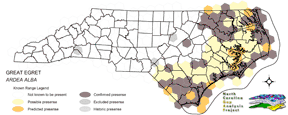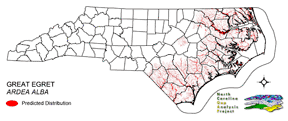
| Taxa: |
| Order: |
| Family: |
| Aves |
| Ciconiiformes |
| Ardeidae |
| NatureServe Global Rank: |
| NatureServe State (NC) Rank: |
| G5 |
| S4B,S4N |
| Federal Status: |
| NC State Status: |
| --- |
| --- |


| Land Unit |
| US Fish & Wildlife Service |
| US Forest Service |
| US National Park Service |
| US Department of Defense |
| NC State Parks |
| NC University System |
| NC Wildlife Res. Com. |
| NC Forest Service |
| NC Div. of Coastal Mgmt. |
| Local Governments |
| Non-Governmental Org. |
| Other Public Lands |
| Private Lands |
| GAP Status 1-2 |
| All Protected Lands |
| Statewide |
| Hectares |
| 41,674.59 |
| 3,011.40 |
| 17,880.12 |
| 6,038.28 |
| 5,832.45 |
| 1,740.69 |
| 18,649.26 |
| 1,764.36 |
| 2,749.86 |
| 49.41 |
| 13,479.03 |
| 446.31 |
| 623,177.64 |
| 76,878.36 |
| 112,519.71 |
| 736,493.40 |
| Acres |
| 102,980.13 |
| 7,441.33 |
| 44,182.73 |
| 14,920.91 |
| 14,412.30 |
| 4,301.34 |
| 46,083.32 |
| 4,359.83 |
| 6,795.05 |
| 122.09 |
| 33,307.40 |
| 1,102.86 |
| 1,539,905.18 |
| 189,970.53 |
| 278,042.20 |
| 1,819,914.47 |
| % of Dist. on |
| Prot. Lands |
| 37.0 % |
| 2.7 % |
| 15.4 % |
| 5.4 % |
| 5.2 % |
| 1.5 % |
| 16.6 % |
| 1.6 % |
| 2.4 % |
| 12.0 % |
| 12.0 % |
| 0.1 % |
| 0.1 % |
| 68.3 % |
| ----- |
| ----- |
| % of Dist. on |
| All Lands |
| 5.7 % |
| 0.4 % |
| 2.4 % |
| 0.8 % |
| 0.8 % |
| 0.2 % |
| 2.5 % |
| 0.2 % |
| 0.4 % |
| < 0.1 % |
| 1.8 % |
| < 0.1 % |
| 84.6 % |
| 10.4 % |
| ----- |
| ----- |
|
Common on the coastal plain and barrier islands (Fussell 1994), Forages in fairly open bodies of fresh or salt water, such as large marshes, the edges of lakes, coastal lagoons, estuaries, wooded river banks (Kaufman 1996), and irrigation ditches (Ehrlich et al. 1988). Nests in, near, or at some distance from these areas. Nests and forages in colonies of up to thousands of birds (Ehrlich et al. 1988), and often in association with other species of wading birds including cormorants, anhingas (Kaufman 1996), and ibises (Ehrlich et al. 1988). Nest is built up to 90 feet above the ground or water in a tree or shrub,or low in a thicket or marsh (Kaufman 1996). Forages by wading in shallow water, or by pirating food from other birds. Pirating may be a more successful technique than foraging (Ehrlich et al. 1988). NATURE SERVE GLOBAL HABITAT COMMENTS: Marshes, swampy woods, tidal estuaries, lagoons, mangroves, streams, lakes, and ponds; also fields and meadows. Nests primarily in tall trees, usually with other colonial water birds; in woods or thickets near water. See Spendelow and Patton (1988) for further details and information on geographic variation in nesting habitat. Returns to the same colony sites year after year. |
| Code | Name | Description | NC Natural Heritage Program Equivalent |
| 3 | Tidal Marsh | Fresh and brackish tidal marshes, including cord grass, wild rice, sawgrass and needlerush alliances. | Brackish Marsh, Interdune pond, Maritime wet grassland |
| 124 | Maritime Scrubs and Tidal Shrublands | Coastal shrubs including wax-myrtle, swamp rose, alder, yaupon, and greenbriar. | Maritime Shrubs, Salt Shrub |
| 375 | Hypersaline coastal salt flats | Tidal flats within salt marshes, including saltmeadow cordgrass or sea-purslane dominated alliances. | Salt Marsh |
| 372 | Interdune Herbaceous Wetlands | Dune swales with permanently flooded to intermittently exposed hydrology. Species composition depends on salinity and can include cut grass, spike-rush, mosquito fern, and hornwort. | Interdune Pond, Maritime Wet Grasslands |
| 75 | Tidal Swamp Forest | Swamp tupelo dominated forest with or without black tupelo and/or cypress trees. Restricted to the tidal zones in the coastal plain. May have inclusions of coastal red cedar woodlands. | Tidal cypress - gum swamp |
| 121 | Maritime Pinelands | Loblolly forests and woodlands of the outer coastal plain. | Estuarine Fringe Loblolly Pine Forest |
| 17 | Maritime Forests and Hammocks | Maritime forests and woodlands dominated by live or sand laurel oak. Estuarine Fringe forests dominated by loblolly pine. | Coastal Fringe Evergreen Forest, Maritime Deciduous Forest, Maritime Deciduous Forest |
| 380 | Coastal Plain Fresh Water Emergent | Emergent vegetation in fresh water seepage bogs, ponds and riverbeds of the coastal plain. Includes alliances dominated by sedges, eelgrass, as well as cane found in unforested cane-brakes. | Small Depression Pond, Sandhill Seep, Floodplain Pool, Unforested Floodplain Canebrake, Riverscour Prairies, Vernal Pools |
| 173 | Coastal Plain Riverbank Shrubs | Shrub dominated riverbanks, commonly dominated by willows and/or alders. | Sand and Mud Bar |
| 50 | Coastal Plain Mixed Bottomland Forests | Includes forests dominated by a variety of hardwood species, including sweetgum, cottonwood, red maple. | Coastal Plain Bottomland Hardwood (in part), Coastal Plain Levee Forest |
| 49 | Coastal Plain Oak Bottomland Forest | Bottomland forests dominated by deciduous oak alliances. Oaks represented can include swamp chestnut, cherrybark, willow, and/or overcup oak. Inclusions of loblolly pine temporarily flooded forests occur in patches. Hydrology is temporarily to seasonally flooded. | Coastal Plain Bottomland Hardwoods (in part) blackwater subtype, brownwater subtype |
| 30 | Cypress-Gum Floodplain Forests | Swamps dominated by black or swamp tupelo with or without Taxodium. Seasonally to semi-permanently flooded hydrology. | Cypress-Gum Swamps |
| 78 | Pond-Cypress - Gum Swamps, Savannas and Lakeshores | Cypress dominated swamps and lakeshores. Can include bays dominated by pond cypress or shorelines of coastal plain lakes with a narrow band of cypress. | Non-riverine Swamp Forest, Natural Lakeshores (in part) |
| 385 | Oak Bottomland Forest and Swamp Forest | The swamp chestnut oak, cherrybark oak, shumard oak and sweetgum alliance is one representative. Other alliances are dominated by water, willow, and overcup oaks. Swamp forests can be dominated by sweetgum, red maple, and black gum being dominant. Loblolly can occur in combination with sweetgum and red maple, or with tulip poplar. Includes saturated and semi- to permanently flooded forests in the mountains. | Piedmont/Mountain Bottomland Forest, Piedmont/Mountain Swamp Forest |
| 238 | Piedmont/Mountain Submerged Aquatic Vegetation | Seasonally to permanently flooded areas with aquatic vegetation. Waterlily, pondweed, hydrilla smartweed are a few of the species that can occur. | Piedmont/Mountain Semipermanent Impoundment (in part) |
| 239 | Piedmont/Mountain Emergent Vegetation | Emergent vegetation of all wetland hydrologies. Sites would commonly support species such as tussock sedge, rushs, and cattail alliances. | Rocky Bar and Shore (in part) |
| 267 | Riverbank Shrublands | Riverside shrubs with temporarily flooded hydrologies. Found in the both the Mountains and Piedmont. Containing dominants such as smooth alder and a Carolina or black willows. | Sand and Mud Bar |
| 269 | Floodplain Wet Shrublands | Saturated shrublands of the Piedmont, includes buttonbush, swamp-loosestrife, decodon and alders. | Piedmont/mountain Semipermanent Impoundment |
| 384 | Piedmont/Mountain Mixed Bottomland Hardwood Forests | Includes temporarily to seasonally forests dominated by hardwood species. Hardwoods include sweetgum, red maple, sycamore which co-occur in a mosaic of bottomland and levee positions. Includes alluvial hardwood forests in the mountains. Hemlock and white pine may occur as inclusions, but are generally mapped separately. | Piedmont/Mountain Alluvial Forest, Piedmont/Mountain Levee Forest |
| 205 | Agricultural Pasture/Hay and Natural Herbaceous | Farm fields used for pasture grass or hay production, as well as old fields dominated by native and exotic grasses. | No equivalent |
| 202 | Residential Urban | Includes vegetation interspersed in residential areas. Includes lawns, mixed species woodlots, and horticultural shrubs. Vegetation accounts for between 20 - 70% of the cover. | No equivalent |
| 8 | Open water | Open water without aquatic vegetation. | No equivalent |
|
DeMauro, M. M. 1993. Colonial nesting bird responses to visitor use at Lake Renwick heron rookery, Illinois. Natural Areas Journal 13:4-9.
Spalding, M. G., J. P. Smith, and D. J. Forrester. 1994. Natural and experimental infections of EUSTRONGYLIDES IGNOTUS:effects on growth and survival of nestling wading birds. Auk 111:328-336. American Ornithologists' Union (AOU). 1995. Fortieth supplement to the American Ornithologists' Union Check-list of North American Birds. Auk 112:819-30. Fleury, B. E., and T. W. Sherry. 1995. Long-term population trends of colonial wading birds in the southern United States:the impact of crayfish aquaculture on Louisiana populations. Auk 112:613-632. Fussell, J.O. III. 1994. A birderís guide to coastal North Carolina. Chapel Hill and London: The University of North Carolina Press. Kaufman K. 1996. Lives of North American Birds. Boston, New York: Houghton Mifflin Company. Frederick, P. C., and M. W. Collopy. 1989. Nesting success of five ciconiiform species in relation to water conditions in the Florida Everglades. Auk 106:625-634. Palmer, R. S. (editor). 1962. Handbook of North American birds. Vol. 1. Loons through flamingos. Yale University Press, New Haven. 567 pp. Payne, R. B., and C. J. Risley. 1976. Systematics and evolutionary relationships among the herons (Ardeidae). Univ. Michigan Mus. Zool., Misc. Publ. No. 150. 115 pp. Harrison, H.H. 1979. A field guide to western birds' nests. Houghton Mifflin Company, Boston. 279 pp. Terres, J.K. 1980. The Audubon Society encyclopedia of North American birds. Alfred A. Knopf, New York. American Ornithologists' Union (AOU), Committee on Classification and Nomenclature. 1983. Check-list of North American Birds. Sixth Edition. American Ornithologists' Union, Allen Press, Inc., Lawrence, Kansas. National Geographic Society (NGS). 1983. Field guide to the birds of North America. National Geographic Society, Washington, D.C. Raffaele, H.A. 1983. A guide to the birds of Puerto Rico and the Virgin Islands. Fondo Educativo Interamericano, San Juan, Puerto Rico. 255 pp. Hilty, S.L., and W.L. Brown. 1986. A guide to the birds of Colombia. Princeton University Press, Princeton, New Jersey. 836 pp. Illinois Fish and Wildlife Information System. 1987. Species book. great egret.37 pp. Pratt, H.D., P.L. Bruner, and D.G. Berrett. 1987. A field guide to the birds of Hawaii and the tropical Pacific. Princeton University Press, Princeton, New Jersey. 409 pp. + 45 plates. Ehrlich, P.R., D.S. Dobkin, and D. Wheye. 1988. The birder's handbook:a field guide to the natural history of North American birds. Simon and Shuster, Inc., New York. xxx + 785 pp. Root, T. 1988. Atlas of wintering North American birds:An analysis of Christmas Bird Count data. University of Chicago Press. 336 pp. Spendelow, J.A., and S.R. Patton. 1988. National atlas of coastal waterbird colonies in the contiguous United States:1976-1982. U.S. Fish and Wildlife Service, Biological Report 88(5). x + 326 pp. Byrd, M.A., and D.W. Johnston. 1991. Birds. Pages 477-537 in K. Terwilliger, coordinator. Virginia's endangered species:proceedings of a symposium. McDonald and Woodward Publ. Co., Blacksburg, Virginia. Powell, G. V. N. 1987. Habitat use by wading birds in a subtropical estuary:implications of hydrography. Auk 104:740-749. Stiles, F.G., and A.F. Skutch. 1989. A guide to the birds of Costa Rica. Comstock Publ. Associates, Cornell University Press, Ithaca, New York. 511 pp. |
For more information please contact them at:
NC-GAP Analysis Project
Dept. of Zoology, NCSU
Campus Box 7617
Raleigh, NC 27695-7617
(919) 513-2853
www.basic.ncsu.edu/ncgap